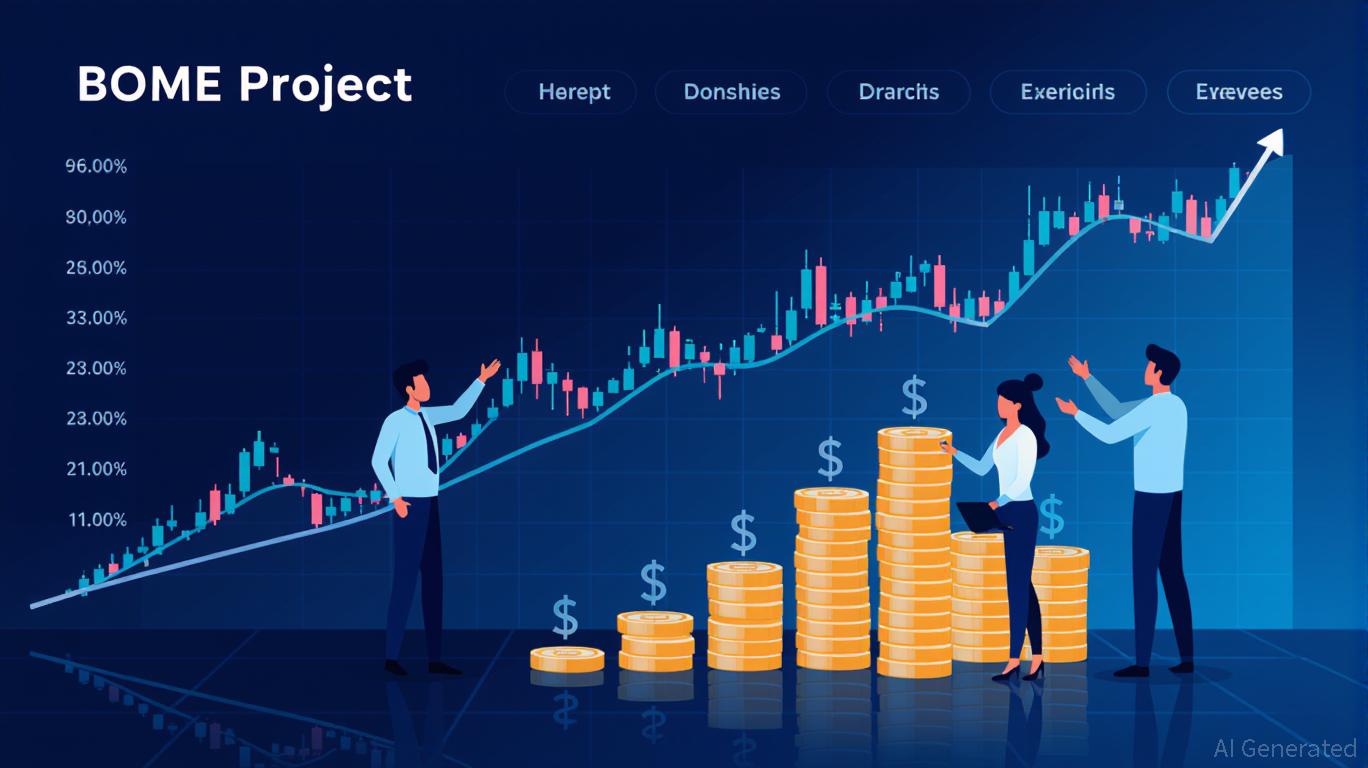Ethereum's Institutional Takeover and Market Cap Overtaking Bitcoin: A Scarcity-Driven Revolution
- Ethereum's dynamic deflationary model, driven by EIP-1559 and institutional buying, is challenging Bitcoin's dominance by creating engineered scarcity. - BitMine's weekly ETH purchases and staking strategy reduced supply by 45,300 ETH in Q2 2025, boosting staking yields and institutional confidence. - Ethereum ETFs attracted $9.4B in Q2 2025, outpacing Bitcoin, as institutions view ETH as a utility asset with compounding value. - Analysts project Ethereum's market cap to overtake Bitcoin by 2025, driven
The crypto asset landscape is undergoing a seismic shift. For the first time in history, Ethereum (ETH) is not merely competing with Bitcoin (BTC) for market dominance—it is redefining the rules of valuation itself. Institutional investors, once anchored to Bitcoin's gold-like scarcity narrative, are now pivoting to Ethereum's deflationary mechanics and utility-driven scarcity models. This transition is not speculative; it is a calculated reallocation of capital driven by data, regulatory clarity, and the emergence of scarcity-driven valuation frameworks.
The Scarcity Paradigm: From Fixed Supply to Dynamic Deflation
Bitcoin's fixed supply of 21 million tokens has long been its primary scarcity mechanism. However, Ethereum's post-merge transition to a proof-of-stake model, combined with EIP-1559's burn rate, has created a new paradigm: active supply contraction. In Q2 2025, Ethereum's annualized issuance rate fell to 0.7%, while its burn rate averaged 1.32%. This net deflationary pressure has reduced the total supply by 45,300 ETH in a single quarter—a figure that dwarfs Bitcoin's annual halving-driven supply reductions.
The implications are profound. Unlike Bitcoin, where scarcity is static, Ethereum's scarcity is engineered. Corporate entities like BitMine Immersion Technologies (BMNR) are accelerating this trend. By purchasing 190,500 ETH weekly and staking 105,000 ETH, BitMine has created a flywheel of value: lower supply, higher staking yields, and compounding net asset value (NAV). At $4,808 per ETH, BitMine's treasury now holds $8.82 billion in Ethereum, representing 1.5% of the total supply. This is not speculation—it is institutional-grade asset engineering.
Institutional Flows: Ethereum ETFs and the Great Capital Shift
The SEC's 2025 reclassification of Ethereum as a utility token has unlocked a flood of institutional capital. Ethereum-based ETFs, such as BlackRock's ETHA and Fidelity's FETH, attracted $9.4 billion in net inflows in Q2 2025—far outpacing Bitcoin's $548 million. This divergence reflects a broader trend: institutions are no longer evaluating crypto assets solely as speculative commodities but as utility assets with compounding value.
Ethereum's dominance in the stablecoin market (51% of the $142.6 billion sector) further cements its institutional appeal. Unlike Bitcoin, which remains a store of value, Ethereum is a platform for financial innovation. Its role in decentralized finance (DeFi), tokenized assets, and smart contracts creates a self-reinforcing ecosystem where demand for ETH grows with usage. Daily on-chain transactions now exceed 1.5 million, a 300% increase from 2023.
Market Cap Overtaking: A Matter of Time
Ethereum's market share has risen from 9.2% to 14.4% in 2025, while Bitcoin's dominance has fallen to 57.2%. Analysts project this trend to accelerate as Ethereum's supply dynamics tighten. BitMine's $20 billion equity raise—a direct bet on Ethereum's institutional future—contrasts sharply with Bitcoin's static supply model, where corporate treasuries hold only 2.6% of the total supply (554,670 BTC).
The key to Ethereum's potential market cap overtake lies in its dual-income model: price appreciation and yield generation. BitMine's staking strategy, for instance, generates $87 million in annualized yields from 105,000 ETH. This creates a compounding effect: lower supply increases equity valuations, while rising ETH prices amplify portfolio value. For investors, this translates to a multi-pronged opportunity:
1. ETF Exposure: Ethereum ETFs offer liquid, regulated access to a deflationary asset.
2. Equity Plays: Companies like BitMine, which combine Ethereum accumulation with low-cost staking infrastructure, are prime candidates for capital appreciation.
3. Staking Infrastructure: Providers like Lido and Rocket Pool benefit from Ethereum's growing utility and institutional demand.
Risks and the Road Ahead
Ethereum's path is not without risks. Price volatility remains a concern, and regulatory uncertainty around staking and tokenization persists. However, BitMine's $1 billion stock buyback program and $2.8 billion daily liquidity provide a buffer against market fluctuations. Moreover, Ethereum's network effects—driven by DeFi, NFTs, and tokenized real-world assets—create a moat that Bitcoin lacks.
For investors, the message is clear: Ethereum's scarcity-driven valuation model is not a fad but a fundamental shift in how digital assets are priced. With a price target of $7,500+ by year-end 2025, Ethereum is positioned to not only challenge Bitcoin's dominance but to redefine the entire crypto capital stack.
In conclusion, the institutional takeover of Ethereum is not about replacing Bitcoin—it is about building a new financial system where scarcity is dynamic, utility is compounding, and capital flows are driven by innovation. For those who recognize this shift early, the rewards will be exponential.
Disclaimer: The content of this article solely reflects the author's opinion and does not represent the platform in any capacity. This article is not intended to serve as a reference for making investment decisions.
You may also like
Book of Meme (BOME): A High-Potential Meme Coin with a Strategic Presale and ROI Catalysts
- BOME's 2024 presale and community fund strategy drove a 36,000% price surge, showcasing meme-driven crypto ROI potential. - Despite an 85% retracement to $0.0021, analysts highlight BOME's Arweave/IPFS integration and Bitcoin inscriptions as future growth catalysts. - However, 50% token concentration in early investors and lack of governance pose dumping risks, categorizing BOME as high-risk speculative asset.

Celebrity-Backed Memecoins: A Systemic Threat to Retail Investors
- Celebrity-backed memecoins prioritize insider gains over public value, creating volatile markets with liquidity traps and artificial price collapses. - Tokens like YZY (70-94% insider allocation) and TRUMP (80% insider control) exemplify centralized tokenomics enabling rapid price manipulation and wealth concentration. - Regulatory ambiguity allows enforcement gaps, as seen in Kim Kardashian's $1.26M fine for undisclosed promotion, while self-paired liquidity pools facilitate insider exploitation. - Acad

Silver's Silent Revolution: Contrarian Signals in the Shares Silver Trust (SLV) Suggest a Strategic Entry Point for 2025
- The Shares Silver Trust (SLV) emerges as a strategic entry point for contrarian investors in 2025, driven by undervalued silver fundamentals and structural supply-demand imbalances. - Weakening U.S. dollar, industrial demand surges (10% annual solar-driven growth), and a record 87.9 gold-silver ratio signal potential for a sharp silver rebound. - Oversold technical indicators (RSI 24.84, golden cross) and $3.61B 3-month inflows highlight shifting investor sentiment toward silver’s dual role as industrial

PARTI +183.33% in 24 Hours on Strong Short-Term Momentum
- PARTI surged 183.33% in 24 hours, becoming one of the market's most volatile assets. - The price spike broke key resistance levels, driven by algorithmic trading and strong retail/institutional demand. - PARTI's 63,280% annual gain highlights its speculative nature and outperformance during market volatility. - A backtesting strategy is proposed to systematically capture explosive short-term gains through volatility-pattern trading.
